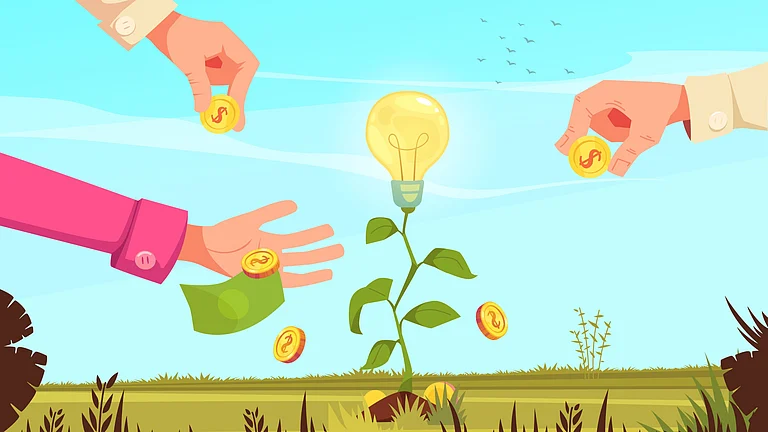The Indian rupee has been on a downward spiral for the last few days and on Wednesday, it hit a record low of 79.03 against the US dollar. This has sparked a debate among analysts about whether the domestic currency could see further decline amid weak fundamentals.
The rupee is down nearly 6 per cent since January this year. However, on Thursday, it managed to recover from its record low after gaining 13 paise to hit 78.90 against the dollar.
Now, this is a double whammy for the common man with the country reeling under high inflation and the prices of everyday items drastically going up.
Union Finance Minister Nirmala Sitharaman, however, recently said that the Indian currency is relatively better placed than other global currencies against the greenback.
In the meantime, as the currency volatility continues, let’s decode what this means for you:-
Why Is Rupee Falling?
The value of the Indian rupee to the US Dollar works on a demand and supply basis. If there is a higher demand for the US Dollar, the value of the Indian rupee depreciates and vice-versa.
If a country imports more than it exports, then the demand for the dollar will be higher than the supply and the domestic currency like Rupee in India will depreciate against the dollar.
The rupee's fall these days is mainly due to high crude oil prices, a strong dollar overseas, and foreign capital outflows.
The rupee has been on the decline since early this year, especially after supply chain disruptions in view of the Russia-Ukraine war, global economic challenges, inflation, and high crude oil prices, among other issues.
Besides, there have been heavy foreign fund outflows from the domestic markets as the foreign institutional investors (FIIs) have sold shares worth $28.4 billion so far this year, outstripping the $11.8-billion sell-off seen during the Global Financial Crisis of 2008. The rupee has depreciated 5.9 per cent versus the dollar so far this calendar year.
As money flows out of India, the rupee-dollar exchange rate gets impacted, depreciating the rupee. Such depreciation puts considerable pressure on the already high import prices of crude and raw materials, paving the path for higher imported inflation and production costs besides higher retail inflation.
Meanwhile, the US Federal Reserve recently increased the interest rates, and the return on dollar assets increased compared with those of emerging markets such as India. Speculations are there could me more aggressive rate hikes by the US Fed and that may further dent the Indian currency.
How does a weak rupee impact you and the economy?
Since India mostly depends on imports, including crude oil, metals, electronics, etc. the country makes payments in US dollars. Now if the rupee is weak, it has to pay more for the same quantity of items. In such cases, the cost of raw materials and production goes up which gets passed on to the consumers.
On the other hand, a weakening domestic currency boosts exports as shipments get more competitive and foreign buyers gain more purchasing power. However, in the current scenario of weak global demand and persistent volatility, exporters are not supportive of the currency fall.
The falling rupee's biggest impact is on inflation, given India imports over 80 per cent of its crude oil, which is the country's biggest import. The global crude prices have sustained at over $100 a barrel since Russia's invasion of Ukraine in February this year. High oil prices and a weaker rupee will only add to inflationary pressures in the economy.
How Crude Oil Prices Affect Rupee?
India depends heavily on crude oil imports to meet over 80 per cent of its energy requirements. Whenever oil prices see an uptick, it tends to pressurise the rupee as India’s import bills soar over higher crude prices.
In May, the Brent crude touched $110 a barrel, which has now jumped to $122 per barrel. If oil prices are rising, it means imports are rising continuously. This pushes up the demand for the US dollar which strengthens the dollar against the rupee. The Indian rupee has been on the decline since January this year, this erodes the purchasing power of the Indian currency in the international market.
Is the Rupee likely to see more decline?
Several analysts believe the Rupee could decline further against the dollar in the next few sessions as oil prices go up and the FII sell-off continues.
As per analysts, the fundamentals of the Indian economy have deteriorated.
But this is where RBI’s role comes into play and the central bank has been taking actions to stall the free fall. In May, it used India’s huge stockpile forex reserves to prevent the rupee from hitting the Rs 77.5 level against the US dollar.
Will the RBI intervene further?
The Reserve Bank of India (RBI) is fighting on several fronts to slow the rupee’s decline to fresh records.
The central bank is said to have sold dollars at 78.97-78.98 per US dollar on Wednesday and has heavily expanded its foreign exchange reserves to shield the rupee from a runaway depreciation. Since February 25, the headline foreign exchange reserves have declined by $40.94 billion.
There are chances that the central bank may intervene further as the rupee sees a further decline.
Last week, RBI Deputy Governor, Michael D Patra said the central bank will not allow "jerky movements" of the rupee and stressed that the Indian currency has witnessed the least depreciation in recent times.
"We will stand for its stability and we are doing it. We are there in the market and we will not allow disorderly movement of the rupee. We have no level in mind, but we will not allow jerky movement. That is for certain," Patra had said.































